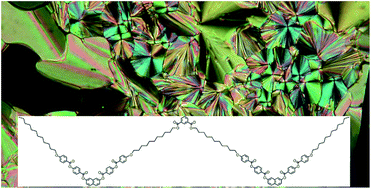W-shaped liquid crystalline dimers†
Abstract
We present a completely new structural type of W-shape dimers based on naphthalene-2,7-diol and 7-hydroxynaphthalene-2-carboxylic acid. First, bent-core monomers with a terminal hydroxyl group were designed and their mesomorphic properties established. Various modifications of the W-shape dimers were synthesised when two fully developed bent-core monomers were joined together with an isophthalic acid moiety, which introduced the additional inner molecular bend. The W-shape dimers demonstrated that their mesomorphic properties are more complex and versatile in comparison with the corresponding bent-core systems. Contrary to the corresponding monomers, most dimers are enantiotropic and reveal rich polymorphism. Even dimers created from non-mesogenic monomers exhibit mesophases, so the stabilising effect of the dimerisation process can be emphasised.


 Please wait while we load your content...
Please wait while we load your content...